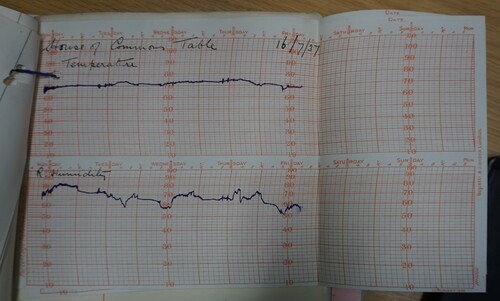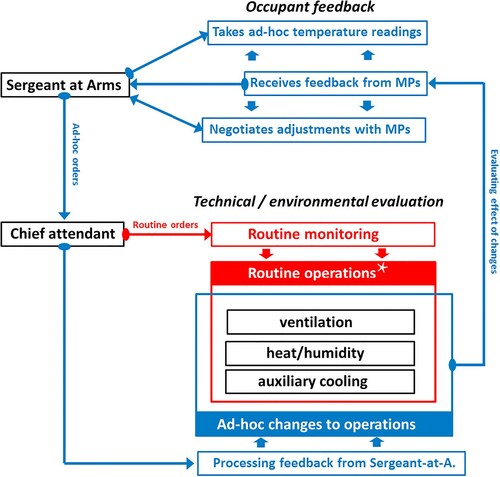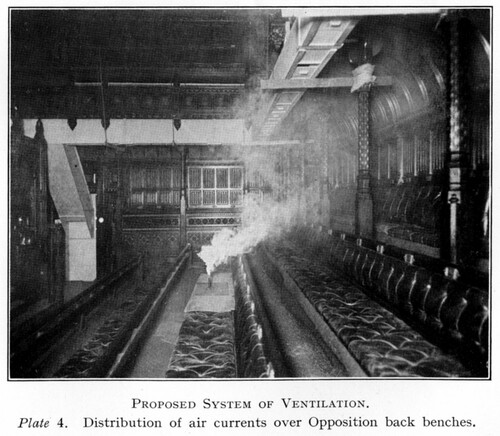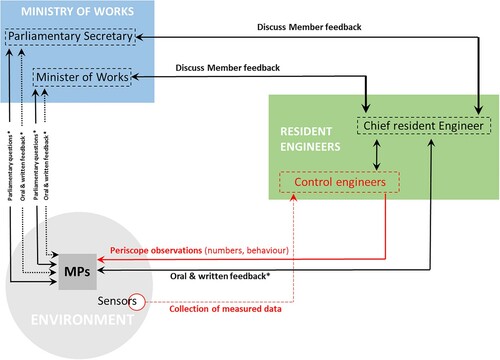ABSTRACT
Building scientists have retraced the origins of modern post-occupancy evaluations (POEs) to the 1960s, but this paper shows that the use of POEs and their integration into the process of improving building performance has been a more longstanding practice. Focusing on the post-occupancy history of the House of Commons from 1854 until 1941 as a case study, this paper examines the nature and functions of these earlier precursors of modern POEs. A review of original archive material illuminates how POEs allowed Parliament as an organization to establish a large repository of knowledge on building performance, offering insights into technological, environmental and human factors. To understand the nature of these historic practices, however, it is critical to distinguish between POE functions that were embedded within the routine operational procedures, led by an in-house team of attendants, and those covered by several larger studies. The latter were more in-depth inquiries conducted by the Office of Works in collaboration with parliamentary committees, scientific researchers and in-house technical staff. These historic practices have also highlighted the role of institutional structures in enabling better collaboration between end users and facilities management in the process of operating, assessing and improving buildings in use.
Introduction
The building scientist William Bordass (Citation2003) wrote that modern organizations have lost the ability and skills to create in-house knowledge of how their buildings are performing. He argued that this included a loss of familiarity with the methods and tools required to study buildings in use, an issue he proposed to address by developing a portfolio of standard feedback methods. Aside from providing an understanding of the actual performance of buildings through monitoring and assessments, the function of post-occupancy evaluations (POEs) is to assess and improve the functionality of buildings from a user perspective. The latter included identifying the needs and expectations of occupants and implementing physical and operational adjustments designed to meet these needs and expectations. In the Post Occupancy Review of Building Engineering (PROBE) Studies, a programme of performance case studies conducted between 1995 and 2002, Bordass’s team used a variety of methods to cover technical, environmental, managerial and human factors of performance. The latter involved the use of semi-structured interviews with facilities managers, focusing on their experience with operating buildings, and questionnaire-based surveys, which were used to rate user experience, covering aspects such as thermal comfort and the perceived level of control over heating, cooling, lighting and ventilation (Leaman, Stevenson & Bordass, Citation2010).
Leaman and Bordass (Citation2001) and Preiser and Hardy (Citation2015) retrace the origins of modern POEs to the 1960s, but POEs have been a much more longstanding practice. Using the post-occupancy history of the House of Commons as a case study, this paper examines the historic practices. Charles Barry’s design for the debating chamber of the House of Commons, which was part of the Palace of Westminster, London, and was completed in 1852, incorporated complex arrangements for ventilation and climate control. These arrangements were in constant use for 87 years, but throughout this period the chamber underwent physical and operational changes and its performance was also the subject of empirical evaluations. Studies were undertaken in different parts of the palace, but the House of Commons is chosen as the focus of this paper because it was the area where studies of building performance were most extensive. It was unusual in terms of the depth and number of investigations, but the practice of empirically evaluating buildings in use was not unique to the House of Commons. In the 19th century, various public buildings had been subject of POEs, including, amongst others, the Crystal Palace (Schoenefeldt, Citation2011, Citation2008), the Natural History Museum (Cook & Hinchcliffe, Citation1996), the Royal Courts of Justice (The Times, Citation1887, p. 3) or Smithfield Market (Yu, Citation2015) and St George’s Hall in Liverpool (MacKenzie, Citation1863). The aim of this paper, however, is not to provide a comprehensive history of early POEs, but to use the House of Commons as a site where historic practices can be studied in depth.
The first ventilation and indoor climate control system of the House of Commons was developed by the physician David Boswell Reid between 1840 and 1852, but was only operational for two years before it was substantial altered in response to pressure from Members of Parliament (MPs), who were dissatisfied with the thermal environment. The system was subject of two major inquiries led by Select Committees (House of Commons, Citation1852, Citation1854a). These comprised scientific studies, the consultation of expert advisors, interviews with facilities management staff and end users. The system was also altered to undertake a full-scale trial of alternative arrangements proposed by Goldsworthy Gurney, one of the advisors. Following the trials, during which MPs were directly involved in assessing its performance from a thermal comfort perspective, the new arrangements were adopted permanently (House of Commons, Citation1854b). Gurney also supervised its operation for eight years, during which he implemented a control regime that integrated formal procedures for user feedback (Gurney, Citation1855).
The post-occupancy history of Reid’s original system, which has already been examined (Schoenefeldt, Citation2016, Citation2018), will not be covered in this paper. Instead, the focus is on the period after Gurney’s interventions. An analysis of the original archival material has yielded detailed insights into these historic practices, illuminating the various ways in which knowledge of performance was acquired and used. This paper examines these 19th-century precursors of modern POEs and focuses on the role of occupant and facilities management staff in the assessment and improvement of environmental control. The research shows that different methods were deployed to facilitate and manage occupant participation, in the context of both the day-to-day management and several larger inquiries. It ranged from consulting MPs and other users about their experiences and expectations, to studies that engaged MPs directly in the testing of design solutions, to involvements in committees responsible for coordinating larger investigations.
The operational procedures incorporated key components of modern POEs, such as user surveys, environmental monitoring, and the testing and fine-tuning of operational regimes. The staff responsible for operating the system kept records of physical measurements, conducted observations of its behaviour under different conditions, and also followed procedures for the collection and review of feedback from MPs. In contrast to contemporary user surveys, these procedures were ongoing, thereby enabling a continual engagement with occupants.
This paper also explores how MPs as the main users of the House initiated, at times coordinated, larger building performance evaluations through Select Committees, collaborating with the Office of Works and teams of scientists and engineers. Between 1852 and 1914, the House of Commons had appointed no fewer than 10 Committees to gain deeper insights. These followed more systematic and scientific approaches to performance evaluation. The largest inquiry into improving the 19th-century system was conducted between 1901 and 1938. These re-examined its performance from technological, epidemiological, thermal comfort and air quality perspectives. They also involved tests with physical models, trials with mock-ups inside the debating chamber, scientific studies of internal conditions and empirical evaluations of modifications. These investigations culminated in plans for a fundamentally new approach to ventilation and climate control, which, although it was never realized, strongly influenced the development of a new system for the post-war debating chamber.
Institutional structures: creating in-house knowledge of performance
Throughout the building’s operational life, the Civil Service administered the maintenance and management of ventilation. This was significant as it provided the organizational structures and institutional continuity needed to build a large repository of in-house knowledge of its performance covering several decades. This repository contained detailed records of measurements, occupant feedback, as well as documentation of various alterations, scientific studies and parliamentary inquiries. Today these records are held by the National Archives, Historic England, Parliamentary Estates and Parliamentary Archives.
The responsibility for facilities management at the Palace of Westminster, which included the maintenance and operation of the lighting, ventilation and warming facilities, was held by the Office of Works and Public Buildings (OWPB), which in 1943 became the Ministry of Works. The OWPB employed the staff of the Palace’s in-house Ventilation Department, which was responsible for operating and maintaining the heating and ventilation in the whole palace. This was a labour-intensive manual process that required large numbers of staff. In 1906, the First Commissioner, Lewis Harcourt, reported that the department had 74 employees (House of Commons, Citation1906a). Staff included stokers, engineers and ‘labourers’ for the operation of the systems and routine maintenance repairs to steam engines, pipework and boilers (House of Commons, Citation1855–56). The department was managed by a superintending engineer, also referred to as the ‘Officer in charge of the warming and ventilating arrangements’ (House of Commons, Citation1871–72) and separate attendants were employed by each House to supervise the operation of the complex systems in the two debating chambers. In the House of Commons the Serjeant-at-Arms Department employed its own ‘Attendant on ventilation’ to coordinate the staff undertaking the monitoring and control operations (House of Commons, Citation1862–63).
The First Commissioner of Works, who was a cabinet minister heading the OWPB, communicated with the superintendent about complaints from MPs, substantial technical issues or plans for alterations to the ventilation arrangements. The role of the superintendent was held by individuals with scientific or civil engineering backgrounds.
Reid, a physician, was superintendent of his system for the first six months, after which the role was transferred to Alfred Meeson (Schoenefeldt, Citation2018). As Clerk of Works in Charles Barry’s office, Meeson had worked closely with Reid on the design of the system and, since 1847, had also been supervising the ventilation in the House of Lords (House of Lords, Citation1854). Gurney, who had remodelled Reid’s system in 1854, held the role of superintending engineer for eight years (House of Commons, Citation1857–58, Citation1871–72). After his retirement in 1862, the responsibilities were transferred to the metallurgist Dr John Percy from the Royal School of Mines. He made further significant changes in the 1860s (House of Commons, Citation1884).
In the late 19th century, the management was simplified to reduce operational costs. In 1872, the Serjeant-at-Arms discontinued the employment of a separate attendant for the House of Commons and his responsibilities were transferred to the Clerk of Works of the Ventilation Department, a post held at the time by the engineer Jacob William Prim. In 1902, Prim reported that he fulfilled many of the attendant’s roles. Alongside managing the staff working in the air chambers below and above the House, he spent considerable time inside the House observing and liaising with MPs. He reported that he had sat in the House:
so that I had cognisance of everything that was going on, and then met the Members and heard their various opinions, which at times very much conflicted one with the other.
(House of Commons, Citation1902, Q107)
The employment of a superintendent to head the ventilation department was also discontinued after Percy’s death in 1889 and his responsibilities were amalgamated with those of the resident engineer (House of Commons, Citation1890–91b, pp. 92–93, Citation1892–93). Prim, who had been promoted in 1889, was the first resident engineer to hold these new responsibilities (House of Commons, Citation1902). He was succeeded by John Palfreeman, 1897–1901, Arthur Patey, 1901–07, William Bradshaw, 1907–19, W. Bowden, 1919–27, and Arthur Hattersley, 1927–57.
A manually operated intelligent system
Operating the system of the House of Commons was a complex and labour-intensive manual process managed by staff of the Ventilation Department. According to a report from February 1930, this team was composed of 12 men, five of whom were stationed inside the fresh air chamber below the floor and seven in the vitiated air chamber above the ceiling (Office of Works, Citation1930). Aside from operating the humidification, heating and cooling plant or the coke fires inside the ventilation shafts, the attendants had to record monitoring data and operate a large number of valves inside the air chambers (). These valves were provided to adjust the indoor climate and the quantity of air supplied or extracted ( and ). The extract for the debating chamber was controlled through three sets of valves. These were used to control the quantity of air exhausted via the main ventilation shaft inside the Elizabeth Tower (House of Commons, Citation1906b, p. 50) and a smaller shaft above the Members Lobby (Office of Works, Citation1867a). Separate valves were also provided to regulate the ventilation and climate inside the spaces surrounding the debating chamber, such as the Members Lobby, Division Lobbies, lavatories and Ladies Gallery (Office of Works, Citation1867a, Citation1867b, Citation1867c; Ministry of Works, Citation1942) ().
Figure 1. Illustrations of the manual monitoring and control procedures, 1875.
Source: The Graphic (Citation1875).
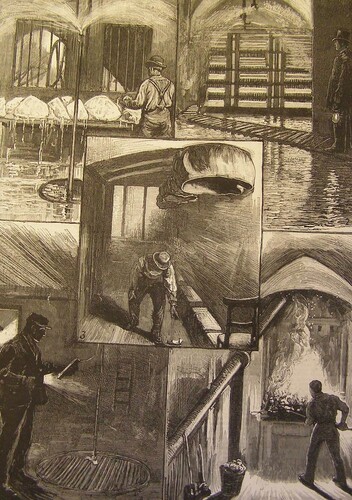
Figure 2. Diagrammatic cross-section showing the arrangement of air chambers and valves above and below the House.
Notes: 1, Vitiated air chamber above the ceiling of the debating chamber; 2, equalizing chamber below the perforated floor; 3, air chamber with heating, cooling, humidification and filtration arrangements; 4, down-pull shaft linking the floor to the vitiated passage of the Clock Tower; 5, vitiated air passage leading to the shaft inside the Clock Tower; 6, perforated floor; 7, ventilation shaft above the Commons Lobby; 8, coke fire at the base of the shaft; and 9, down-pull shafts connecting the vitiated air chamber above the ceiling to passages at the basement level. Valves: a, for air supply to the debating chamber; b, for control of the floor-level extract; c, for controlling air extract via the Clock Tower; d, sliding valve for controlling the air extract via the shaft above the Commons Lobby; e, of the down-pull shaft (Clock Tower); and f, for supply to the Commons Lobby.
Source: Schoenefeldt (Citation2018).
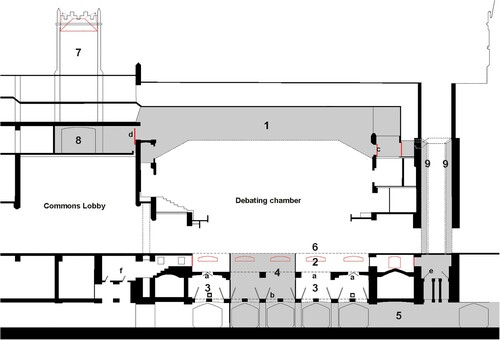
Figure 3. Floor plan, 1940s, showing the air chambers above the ceiling with separate valves for the debating chamber and surrounding lobbies.
Source: Historic England Archive, Chest 13: House of Parliament, fragile.
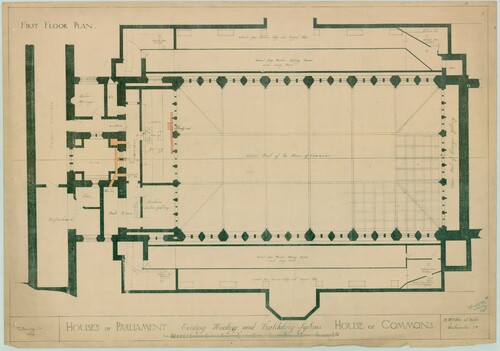
As a direct consequence of its reliance on manual labour for the control of the system, staff had to constantly observe its behaviour, and as staff changes were rare, the team could accumulate years of in-practice knowledge of working the system under a variety of conditions. The technical staff served for 18–60 years and many ‘workmen’ (House of Commons, Citation1930) began their careers as junior staff who were trained in-house to acquire the specialist knowledge and skills required to operate it (House of Commons, Citation1898; Office of Works, Citation1930). In 1884, Percy noted that the staff was ‘pretty well-trained’ through their long experience and intuitively ‘know exactly what the right quantity of air is’ (House of Commons, Citation1884, Q40). The Times (Citation1870, p. 6) wrote that the ‘data, with long experience, enable them to preserve an even temperature’.
Feedback on the system’s behaviour was gained through personal observations, environmental monitoring and review of user feedback. From the formal opening of the House of Commons in February 1852 until its destruction by Luftwaffe bombing in May 1941, staff were continually engaged in the gathering of performance data in conjunction with its management. It followed an environmental monitoring regime that incorporated formalized manual procedures for the collection of data on the indoor climate, external weather conditions, technical operations, user experience and changes in the number of MPs sitting. Changes could be sudden and drastic, in particular before and after debates or during votes, when there was a sudden movement of large numbers between the House and the Division Lobbies. Information was systematically recorded in standardized log-sheets with columns for numerical and qualitative data. This regime enabled attendants to maintain a constant supply of up-to-date information on the system’s performance. This monitoring process, first introduced by Reid in 1852 (Schoenefeldt, Citation2016), had been tested and refined inside the Temporary House of Commons, where it was used between 1837 and 1851, and inside the Temporary House of Lords from 1839 until 1847 (Schoenefeldt, Citation2014) (). The purpose of these monitoring procedures, Reid (Citation1844) wrote was to:
enable the attendants to acquire experience in the various contingencies which they have to meet, and particularly, to enable them to anticipate, as far as possible, every expected change of atmosphere.
(p. 325)
Figure 4. Page from the logbook for April 8, 1853, showing the recorded measurements and notes on feedback and operational procedures.
Source: Parliamentary Archives, OOW/5/1.

The House was equipped with a large array of scientific instruments to monitor the system in operation. According to logbooks from the 1850s (Ventilation Department, Citation1853, Citation1854), the monitoring system was composed of 39 scientific instruments in different locations (). These included a barometer, anemometer, 33 thermometers and four hygrometers. Separate readings were taken in the debating chamber, Division Lobbies and Members Lobby, but also externally and inside the air chambers. Ten thermometers were provided to monitor the conditions at key locations inside the debating chamber. A thermometer was installed in each gallery and six on the principal floor below. The latter were positioned near the Bar, Speaker’s chair and in the middle of the benches on the opposition and government sides. The logbook also had margins for written comments, which referred to observations of external air pollution, routine and ad-hoc operational changes, feedback from MPs and instructions received from the Serjeant-at-Arms or Speaker.
The collection and processing of data was undertaken entirely manually. Every hour readings from each instrument had to be recorded by hand and good team coordination was required to consolidate data from different locations. Data were first logged by individual attendants in local registers, then they were handed in to the ventilation office to be transcribed into a central logbook (House of Commons, Citation1852, pp. 545–548). Operationally, the House of Commons had the characteristics of modern intelligent buildings (closed-loop system), but due to the absence of computers, sensors and modern communication technology, it was entirely dependent on the intelligent management and physical labour of human operators. The result was a high level of direct human involvement in the process of gathering, interpreting and using data to inform operational decisions. In modern buildings with building management systems (BMS), in contrast, data are collected and processed autonomously by computers, and systems automatically adjust following a set of algorithms. Attempts to automate the logging of data did not go beyond the installation of self-acting instruments, such as thermographs and hygrographs (House of Commons, Citation1903, Q188–Q191; Hattersley, Citation1945; Markham Citation1937) (). First steps towards automating monitoring and control were undertaken after the Second World War, when the new chamber was equipped with a network of remote electronic sensors feeding data to a central control room through electric wires (Engineering, Citation1950, p. 396).
Managing user participation
The climate and ventilation were managed centrally on behalf of occupants. The staff were following a ‘programme’ with a set range of temperature, humidity and ventilation rates that were to be maintained inside the House. Not dissimilar to the algorithms of a modern BMS, this programme provided the basis for routine operations. Evidence of the original control manuals used by the attendants could not be found, but several resident engineers have provided detailed accounts of the operations in interviews with Select Committees. shows the parameters for the climate that staff was instructed to maintain inside the House at different periods between 1837 and 1954. The control parameters in the post-war chamber and temporary House have also been included for comparisons.
Table 1. The climate conditions staff were required to maintain inside the House of Commons at different periods between 1837 and 1954.
Note that national standards for indoor thermal comfort, comparable with those introduced by the Chartered Institution of Building Services Engineers (CIBSE) (UK) or American Society of Heating, Refrigerating and Air-Conditioning Engineers (ASHRAE) (US), did not exist in the 19th century. Some guidance was given in the 19th-century technical literature (Tredgold, Citation1824, pp. 3–17; Board of Health, Citation1857, p. 24), but the parameters for the indoor climate inside the House had been determined by staff through their own field observations. In the context of the day-to-day operations, attendants had acquired an intimate knowledge of how the indoor climate affected users, covering factors such as the thermal sensations of internal air currents, air temperature, humidity, seasonal differences in the perception of temperatures or the experience of thermal transitions between the exterior and interior. Reid (Citation1844), who introduced the first set of parameters, wrote that:
as far as I have been able to observe, a temperature of 65°F, with an atmosphere moving in a very gentle stream, so as not to be perceptible, is the most agreeable in rooms that are not overcrowded.
(p. 185)
The control regime also incorporated procedures that allowed routine operations to be temporarily overridden through ad-hoc adjustments, following a review of feedback from MPs (). This enabled the system to remain dynamic and responsive to the user experience. During the sittings, monitoring and recording of temperatures was managed by the Serjeant-at-Arms. He employed an ‘attendant on ventilation’ to supervise the operation of the ventilation in the chamber and surrounding lobbies during sittings (House of Commons, Citation1851–52, pp. 6, 13; Citation1872–73, p. 23). The attendant ‘watched the thermometer and took care that a sufficient supply of air was provided’ (House of Commons, Citation1871). The Serjeant-at-Arms also employed a messenger tasked with collecting personal feedback from MPs and logging hourly temperature readings inside the debating chamber (House of Commons, Citation1852, pp. 580–585). MPs were asked either to notify the Serjeant-at-Arms directly or to ask the doorkeepers and messengers to pass their messages to him. These arrangements provided a formal procedure by which requests and complaints could be communicated and processed centrally. The Serjeant-at-Arms carefully reviewed user responses before any instructions for adjustments were issued to the attendants. Lord Charles Russell, Serjeant-at-Arms from 1848 to 1875, reported that he was the ‘usual medium of communication’ between MPs and attendants (House of Commons, Citation1852, Q255) and he also acted as moderator, engaging with the conflicting views of individual MPs. In 1913, Patey noted that:
on complaint being received, the matter can be immediately investigated, and it can be ascertained whether the complaint is reasonable or otherwise, and action taken accordingly.
(Patey, 1913)
This process could be interpreted as a collectivist approach to occupant-led control, and this level of user engagement added another layer of complexity to the building operation. The interference of MPs at times could become disruptive and undermine the engineers’ ability to manage the system effectively. In 1869, Percy reported when the demands were not adequately moderated he would receive conflicting requests from MPs within a short space of time, making it difficult to operate it effectively (House of Lords, Citation1869, Q97). In a report to the First Commissioner, Percy wrote that it was not possible to meet the expectation of every individual as the susceptibility to climates was affected by personal factors, such as physical exercise, clothing, age, state of health or the increased metabolism experienced after a meal (House of Commons, Citation1866b). In May 1891, the First Commissioner explained to the House that there was a great ‘divergence of opinion’ and that the temperature had to be kept within a range at which the majority felt satisfied. Adjustments to accommodate individuals could not be made as:
for one Member who complains of excessive cold in this House, there are – I was going to say a score – at least a dozen who complain of excessive heat.
(House of Commons, Citation1891)
we have to try to please everybody and I am afraid that any change in the temperature at which the air in the chamber is kept at present would bring me a number of complaints. […] If, however, I find that other people share your view that the House is too cold, I will certainly have the temperature raised somewhat.
(Tomlinson, Citation1945)
it would be of great assistance to the department in the working of the system if honourable members would acquaint the Serjeant-at-Arms, or any of the House messengers, at the time they experience any objectionable feature in the ventilation, so that immediate steps can be taken to rectify complaint.
(Patey, 1913)
Operable windows: the challenges of occupant participation
Gurney’s system also incorporated operable windows for natural cross-ventilation. For this purpose, eight of the stained glass windows above the galleries, which previously had been fixed, were provided with openable sashes (). The cross-ventilation, however, was not intended to complement or replace the stack ventilation during sittings (House of Commons, Citation1854a, p. v). His objective was to deploy windows only temporarily to refresh the atmosphere before and after sittings. During weekdays, Gurney instructed attendants to open the windows from five a.m. until the House returned for sittings, and only reopen them at the end. He argued that it would ‘more freely purify and sweeten’ the House (House of Lords, Citation1854, Q961). MPs, however, were not content with this new regime and within a few weeks had succeeded in overturning it. The Speaker and ‘a great number of Members’ insisted on windows being kept opened for several hours whilst they were sittings, sometimes from 4 to 8 p.m. (House of Lords, Citation1854, Q702–Q707). In July 1854, Robert Vernon Smith, MP for Northampton, reported that windows were frequently opened:
at the bidding of one particular Member, which I think is objectionable as the feeling of a single Member would be no guide with reference to the House generally.
(House of Lords, Citation1854, Q971)
Figure 7. House of Commons debating chamber, 1868, showing the windows opened to ‘flush’ the chamber with fresh air.
Source: Harrington (Citation1869, plate IX).
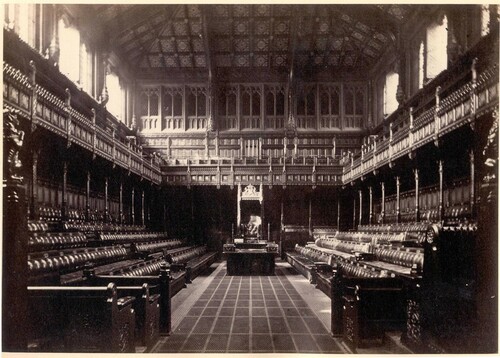
To manage MPs’ interference, a formal process and set of rules for managing the ad-hoc opening of windows during sittings was introduced and integrated into the control regime (). During sittings, the authority to instruct ad-hoc adjustment to the windows was held by the Speaker of the House of Commons or the Chairman of Ways and Means, who acted as the Speaker’s deputy (House of Commons, Citation1854b, Q213–Q215). Windows were typically opened from 5 to 11 a.m. to ‘flush’ the chamber, and a new set of rules was introduced to restrict the use of windows during windy, hot or cold weather. In June 1863, William Cowper, First Commissioner, reported that even if he received requests from MPs, the rule was ‘when the air outside was near 64°F [18°C] windows were opened; when it was considerably more, they were kept closed’ (House of Commons, Citation1863). Percy reported that the purpose of the rule was to prevent uncomfortable temperatures or draughts. He noted that when the difference between indoor and outdoor temperatures was only 2–3°F, windows could be opened without causing ‘sensible draughts’ (House of Lords, Citation1869, Q104), but during hot weather, the opening of windows caused the indoor temperature to rise and compromise the effectiveness of the stack ventilation and cooling (House of Commons, Citation1866b).
Figure 8. Process for collecting and reviewing the personal feedback from MPs, with the Serjeant-at-Arms and the Speaker acting as moderators.
Source: Author.
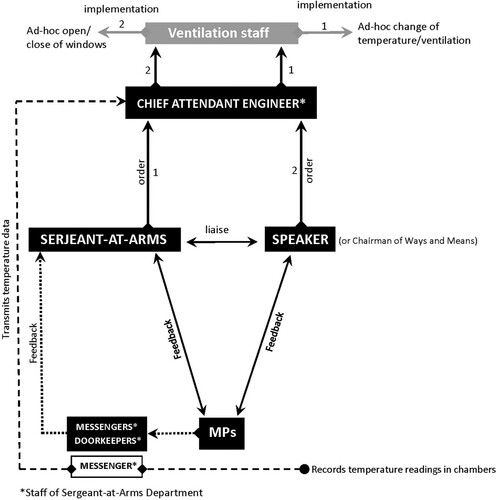
The logbooks for the period between 1923 and 1928 show that the attendants kept meticulous records of the opening and closing of windows, alongside data on other operational procedures (). The registers show times of the daily window opening routine, notes on adjustments made based on weather conditions, taking into account temperature, wind or rain, and comments referring to orders for ad-hoc adjustments issued during sittings. On 10 July 1924, one entry said: ‘4 windows opened on east side of House, 2.55 pm, by order of Mr Speaker, closed at 11.30pm’; and on 6 June 1928: ‘4 windows opened on east side of House, 5.15pm, by order of chairman’. On 30 July 1925, the attendants noted ‘1.40pm 1 window closed, east side, Serjeant-at-Arms order with consent of Mr Speaker’. It also mentions adjustment made in response to complaints from MPs. The register for 7 August 1924, said ‘window no. 4, e. side of House, closed, complaint of draught from Mr. Benn, 12pm’ (Ventilation Department, Citation1923–28).
Figure 9. Page from the logbook, 18–21 July 1923, used to record indoor climate data and written commentaries on the operation of windows.
Source: Parliamentary Archives, OOW/5/3.

These formal procedures were observed continually until 1941. They also continued to be followed between 1941 and 1950 when the House of Commons had been temporarily decanted to the chamber of the House of Lords (Hattersley, Citation1945; Burgess, Citation1946). The Speaker remained responsible for overseeing the opening of windows until 1950 (Wilson, Citation1946c), and the Serjeant-at-Arms continued to act as the formal liaison regarding temperature (Wilson, Citation1946b). In a letter to Hayden Davies, MP for St Pancras South West, dated 1 February 1946, the Minister of Works wrote that it was the ‘usual way’ for MPs to approach the Serjeant-at-Arms, ‘who in turn instructs the engineer at his discretion’ (Burgess, Citation1946).
This shows that user interaction was facilitated through an institutional framework, providing formal channels for communication between technical staff and MPs. By acting as formal interfaces between MPs and the technical staff, the Speaker and Serjeant-at-Arms acquired a central role in the management of the system. They held the responsibility for ensuring MPs’ feedback and requests were fed into the operation of the system in an ordered way. Through this process, the technical staff at times became subservient to orders reflecting the expectation of the House, blurring the boundaries between occupant and operator. In 1889, Richard Power, MP for Waterford, observed that the technical staff only held some of the responsibility for the management, highlighting that ‘variations in temperature are settled by the Speaker or the Chairman [of Ways and Means]’ rather than by the attendants (House of Commons, Citation1889). In 1946, Harold Wilson, then Parliamentary Secretary, wrote that the ‘engineer in attendance’ would only make adjustments when asked by the Serjeant-at-Arms (Wilson, Citation1946a).
The records show that upholding the rules could become challenging as MPs frequently requested windows to be opened during summer irrespective of the heat. During a sitting on 29 June 1863, Cowper reported that the internal temperature was only 65°F whilst that outdoors had reached 78°F (25.5°C), but MPs still insisted on windows being opened (House of Commons, Citation1863). This level of interferences had a significant impact on the House from an operational perspective as the chamber was intended to be permanently sealed and climatically controlled space. The logbooks from the 1920s show that orders to open windows were issued frequently during sittings in summer, when the indoor temperature was almost constantly above 65°F, at times reaching 72–76°F (24°C). According to these logbooks, instructions were given during nearly half the sittings in summer (Ventilation Department, Citation1923–28). Between 6 June and 26 July 1928, windows were opened on request during 19 of 44 sittings, and between 17 May and 19 July 1927, instructions were given on 17 of 48 sitting days. This illustrates challenges with reconciling tensions between operational decisions based on the perception and desires of MPs, which were highly subjective, and those grounded on the professional judgment of the technical staff or the result of measurements.
Role of MPs: critical occupants driving change
These challenges illustrate that environmental control was not a purely technical issue that could be delegated to engineers. Formal procedures were introduced to manage the impact MPs’ participation on the management, but these did not prevent MPs from exercising influence through other mechanisms. MPs used the formal parliamentary procedures, such as motions, debates and parliamentary questions, to express their views and demands and the House also appointed Select Committees to lead several larger inquiries ().
Figure 10. Mechanisms by which MPs influenced the Office of Works and also led their own post-occupancy studies.
Source: Author.
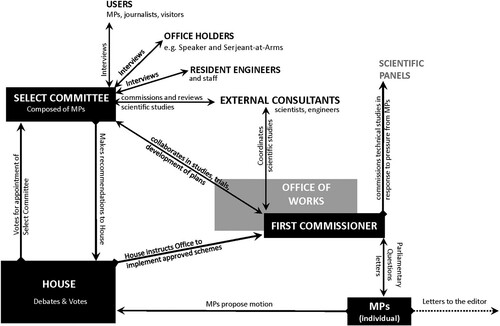
MPs used Parliamentary questions as a forum for sharing their experiences and demands publicly inside the House, and by questioning the First Commissioner, also increased the pressure on the Office of Works to make improvements. At other times MPs raised their concerns to the First Commissioner by letter or personal conversations, and a small number voiced their views in letters to the editors of national newspapers (e.g. Bossom, Citation1937a, Citation1937b). The interaction between individual MPs and the First Commissioner was extensive, and has been documented in Hansard and administrative files of the Office of Works. The files contain correspondence with individual MPs and copies of the internal communication regarding any issues that MPs had raised. Informal oral conversations with MPs were recorded in memoranda and personal notes. These sources provide insights into how MPs were affected by the internal climate conditions. A review of the speeches recorded in Hansard between 1852 and 1941 reveals that the majority of complaints referred to the state of the thermal environment and air quality ().
Figure 11. Subject of complaints voiced by MPs publicly during debates between the 1850s and the 1940s, based on Hansard.
Source: Author.
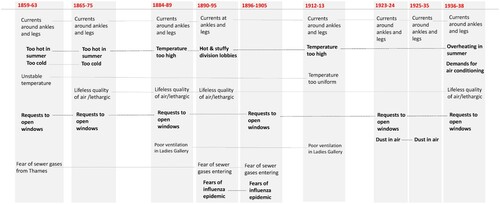
The latter include concerns about unpleasant smells, floating dust particles and also highlighted problems with excluding smoke and other types of external air pollution. Many critiques were about temperature. It was criticized by some for being either too high or too low, whilst others reported discomfort caused by great fluctuations in temperature, which occurred when there was sudden rise or decline in attendance. At other times individuals described the climate as too uniform, and as it made them feel weary, requested more stimulating variable conditions. The most common cause of discomfort was draughts around the ankles and legs. Fresh air was supplied through perforated floors, which was intended to diffuse the currents, but the MPs’ responses showed that they still could become uncomfortable, depending on the ventilation rate and air temperature (House of Lords, Citation1869, Q100; House of Commons, Citation1867–68, Q989).
It would be easy to criticize MPs for being overly sensitive, but the records illustrate that the level of thermal discomfort could become severe and MPs were also exposed to these conditions for several hours. In speeches given in the 1850s and 1860s, for instance, MPs described the internal conditions as disruptive and also adopted behaviours that helped them to cope with the thermal environment. In July 1859, Harry Verne mentioned that he ‘kept a pair of worsted stockings and gaiters for wear in the House, in order to protect his feet from the cold air’ (House of Commons, Citation1859). In a speech given on 19 May Citation1865, Acton Ayrton, MP for Tower Hamlets, claimed that air circulated around the feet to such an extent that it was impossible for ‘hon. Members to remain in it’ (House of Commons, Citation1865) and in April 1866 had noted that it forced MPs to regularly leave the House and ‘stand by the fire to warm themselves’ (House of Commons, Citation1866a).
These issues could be considered a historic illustration of the ‘qualitative performance gap’, which is a term introduced by Coleman and Robinson (Citation2018) to describe the ‘perceived gap between what inhabitants expect and their actual experience of the building environment’ (p. 485). The performance gap, regularly highlighted by formal complaints, drove the Office of Works and Ventilation Department to make various physical and operational changes. Many of these were small and temporary interventions responding to the specific concerns of vocal individuals. Examples of its interactions with individual MPs can found in the Office of Works’ records from the 1930s. It showed that MPs had private conversations and formal written correspondence with the Commissioner of Works. In December 1937, for example, Marvis Tate, MP for Frome, mentioned in a conversation that the air entering below her feet was like a ‘blizzard’, and in March 1938 she wrote formally to the Commissioner that she got ill from constant exposure to the currents (Tate, Citation1938). The Commissioner responded by instructing his staff to raise the air temperature and temporarily close the floor inlets near her seat (Sassoon, Citation1938).
A first detailed technical investigation undertaken in response to complaints from MPs was undertaken between 1866 and 1869. This illuminated technical challenges encountered during first 10 years. Percy described these challenges in reports to the Office of Works and in interviews with Select Committees in 1867 and 1869 (House of Lords, Citation1869; House of Commons, Citation1867–68). He highlighted that the idea of a sealed and climatically controlled chamber was not always achievable and forced technical staff to make operational changes. In hot weather the air shafts were not providing adequate ventilation and the use of evaporative cooling was not sufficient to lower temperatures. Percy reported that the only means available to relieve MPs from high temperatures was by exposing them to gentle currents and that alternative operating regimes were trialled to provide ventilative cooling (House of Commons, Citation1867–68, Q341–Q343). The Office of Works subsequently addressed these issues by introducing new facilities for the supply, filtration and cooling of fresh air, and the stack ventilation was also boosted using a steam-powered fan (). A new air passage was introduced inside the basement to connected the House to new inlets facing the terrace. In this passage the air was cooled by passing it through water sprays and racks with blocks of ice (House of Commons, Citation1884, Q48).
Figure 12. Floor plan showing the second fresh air supply introduced in the 1860s with new cooling and filtration facilities.
Notes: 1, Smog filter (added in the 1890s); 2, Scrim cloth filter used during ordinary levels of air pollution; 3, fresh air passage at the basement level containing racks that were filled with ice for cooling; 4, air inlets facing the terrace; 5, air input chamber containing water jets; and 6, fan used periodically to assist the thermal system in summer during crowded debates or when the smog filters were deployed.
Source: House of Commons (Citation1906b).
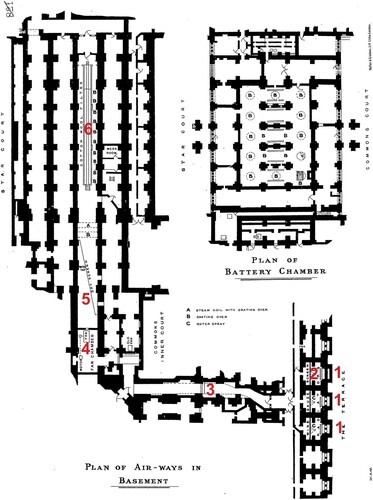
The role of committees: coordinating larger POEs
Aside from influencing the Office of Work through criticism, MPs were proactive in initiating and leading their own technical investigations. Between 1852 and 1914, the House appointed no fewer than 10 ad-hoc Select Committees to coordinate several larger studies.Footnote2 These were standalone studies that typically lasted between one to two parliamentary sessions and incorporated many methodologies associated with contemporary POEs. The Committees used semi-structured interviews to gain a deeper insight into the experience of occupants and technical staff, consulted external advisors and collaborated with the Office of Works and external scientific researchers in convening scientific studies and technical trials. The involvement of scientists allowed the introduction of more rigorous scientific methods into building evaluations, and some of their studies were disseminated through publications in scientific and technical journals (Journal of Hygiene: Graham-Smith, Citation1903; British Medical Journal, Citation1884, Citation1891).
During the first 50 years, the majority of inquiries were concerned with the impact of atmospheric pollution and sanitary conditions. Atmospheric pollution was a serious environmental problem and the studies covered several types of emissions, including those produced by sewage, factory processes and coal-based fuels (House of Commons, Citation1882). The earliest study to examine air quality from an epidemiological perspective were conducted in 1855 (House of Commons, Citation1854–55) in response to a major cholera epidemic; and between 1857 and 1858 Select Committees led inquiries into problems caused by the sewage in the River Thames (House of Commons, Citation1857–58). Up until the completion of Sir Joseph Bazalgette’s metropolitan sewer network in the 1860s, the Thames was used as open sewer, which, in hot weather, produced intense smells (Halliday, Citation2001). The ‘Great Stink’ disrupted parliamentary sittings but also represented a major sanitary issue. Chemists were commissioned to examine its effect on the atmosphere and its ability to convey diseases, which was grounded on the belief that cholera and other infectious diseases were caused by miasmatic airs released from decaying organic material, including human faeces. This miasma theory of disease transmission dominated inquiries for 30 years. It was superseded by the germ theory of disease in the 1880s and resulted in new methods of microbiological analysis being included in air-quality studies. The earliest microbiological examinations were commissioned by Select Committees in 1884 and 1886 to study the emissions from internal sewers, an issue that was resolved in 1888 by the introduction of a mechanical sewer ejector (House of Commons, Citation1884–85, Citation1884, Citation1886).
Over the first 50 years inquiries by Select Committees were largely reactive, comprising individual studies undertaken in direct response to particular issues, but starting in the early 20th century a more strategic approach was adopted, involving larger programmes of studies and more substantial collaborations with scientists from multiple disciplines. The first of such programmes, conducted between 1902 and 1905, was based on a collaboration between the Office of Works, three Select Committees and scientific researchers. The programme covered microbiological studies, and technical evaluations of the existing stacks, fans, cooling and filtration arrangements. These investigations were commissioned in response to several influenza epidemics, which, having affected a large number of MPs, had induced fears that the ventilation was contributing to the spread of viruses (Pall Mall Magazine, Citation1891).
The first part of this programme was coordinated by two Select Committees between 1902 and 1903 (House of Commons, Citation1902, Citation1903) and built on earlier work undertaken by a Select Committee in 1891 and preliminary chemical and microbiological examinations by Thomas Edward Thorpe from the Government Laboratory (House of Commons, Citation1890–91b). In 1902, the Committee engaged John Scott Haldane, a biologist from the University of Oxford, as its chief scientific advisor. He coordinated studies in collaboration with two other scientists, Graham Smith, a microbiologist from the University of Cambridge, and the chemist William John Atkinson Butterfield.
The second part of the study lasted from 1903 to 1905 and was coordinated by the Office of Works. It commissioned scientific studies to determine the source of the influenza virus and trace its movement inside the chamber. The studies were led by Mervyn Gordon, a bacteriologist from the Pathology Unit of St Bartholomew’s Hospital. Gordon collaborated with the chemist William Hurtley and the meteorologist John Aitken. A large number and different types of experiments were undertaken between May and August 1904. These were documented in a report submitted to the Office of Works that December (House of Commons, 1904). Air flow measurements and a smoke test were used to study ventilation rates, trace the paths of internal currents and assess how filters, valves and the geometry of air passages were affecting the flow of the incoming and outgoing air. Another study involved the analysis of air samples collected inside the House and air passages, which were used to quantify the concentration of physical particles, microbes and chemical impurities. These were complemented by microbiological examinations of the filters, dust and dirt, and ‘speaking tests’ were used to trace the spread of bacteria during speeches. The conclusion of Gordon’s study was that the ventilation rate was not sufficient to prevent a higher concentration of microbes inside the atmosphere. It dispersed but did not remove the microorganisms. It also found that the influenza virus was not introduced from outside through the supply air. Most of the microorganisms originated in the mouth, throat and nose of MPs, and were spread through coughing, sneezing and speaking. Microbes settled on the floor and were spread by floating dust particles. The study also found that convection inside the shafts, even with the assistance of coke fires, was not sufficient to provide adequate ventilation, and the existing fan was not strong enough to drive the required quantity of fresh air through the filters (House of Commons, Citation1903, p. ix).
Following recommendations outlined in Gordon’s final report, the Office of Works made several significant alterations that resulted in the abandoning of the 19th-century stack ventilation (House of Commons, Citation1906b). The use shafts with coke fires, including the main shaft inside the Clock Tower, was discontinued and replaced with electric fans to boost the air flow (House of Commons, Citation1902, Q11; Citation1913c, Q96). The floor inlets between the benches were also reconfigured to protect MPs from floating dust particles (House of Commons, Citation1913c, Q55–Q65) (). The Office of Works subsequently appointed an advisory committee to empirically evaluate the impact of the changes. This committee, chaired by Michael Foster, a physiologist from the University of Cambridge, was composed of the resident engineer and the scientists Gordon and Haldane. During the study it also collaborated with other scientists, such as Rudolf Lempfert from the Meteorological Office, Aitken and Hurtley. Similar to earlier studies, these scientists deployed a range of methodologies, such as a smoke test, air flow measurements, climate monitoring, and chemical and bacteriological studies of air samples (House of Commons, Citation1906b, 1906c). In their final report, published in June 1906, the committee concluded that the alterations had succeeded in improving indoor air quality and in increasing the ventilation rate from six to 18 air changes per hour.
Figure 13. Cross-section showing the new arrangements of inlets between benches, which were introduced in 1904 to protect the MPs from rising dust.
Source: House of Commons (Citation1906b), p. 251.
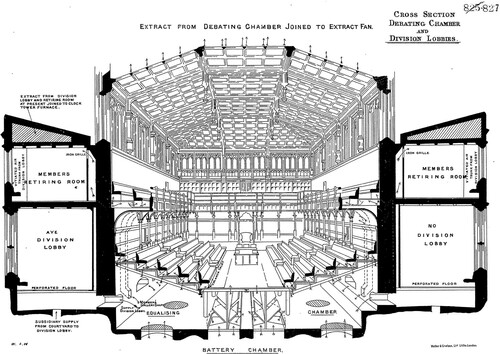
The physiological turn: reshaping the thermal environment
After 1905, the focus of the studies underwent a significant shift from air purity towards thermal comfort and fluid dynamics. In July 1913, eight years after the completion of the last study, the House appointed another Select Committee to re-examine the system from a physiological perspective. It was appointed in response to a growing discontent amongst MPs with the thermal environment. Between 1912 and 1913, individual MPs had repeatedly questioned the Commissioner during parliamentary questions. They criticized the atmosphere for being too hot and uniform and complained about the draughts around the legs (House of Commons, Citation1912a, Citation1912b, Citation1912c), which had become more intense as the result of the changes made in 1904. The issue was debated during two sittings in June 1913 (House of Commons, Citation1913a), and in July the House finally voted for a Select Committee largely composed of MPs who had been outspoken critics of the system (House of Commons, Citation1913b). It engaged Leonard Hill, a physiologist from the Medical Research Council’s (MRC) Department of Applied Physiology, Arthur Barker from UCL’s Department for Heating and Ventilation, and a chemist from London Hospital, to examine the thermal environment (Evening Telegraph, Citation1913). Hill was a pioneer of modern thermal comfort research who significantly influenced the development of American standards for air-conditioned environments in the 1920s (Cooper, Citation1998). His research was disseminated internationally through formal publications, which included ‘The influence of the atmosphere on our health and comfort in confined and crowded places’, a paper presented at the Smithsonian Institution, Washington, DC, in 1913 (Hill, Flack, McIntosh, Rowlands, & Walker, Citation1913) and his book, co-authored with C. Argyll, Health and Environment (1925).
During the Christmas recess of 1913, Hill and Barker undertook experiments inside the chamber. This included trials with life-size mock-ups of a new configurations of inlets that was intended to protect MPs from direct currents (Baines, Citation1923; Fletcher, Citation1926). In January 1914, Hill present the Office of Works with a report summarizing the results and outlining a proposal for remodelling the ventilation based on physiological criteria (House of Commons, Citation1924). In this report, he argued that the main problem was the physiological effect of internal currents rather than air quality. He reported that the incoming air ‘caused a draught which had a cooling effect on the feet and legs of the members whereas there was not sufficient movement of air round their heads and shoulders’ (Hill, Citation1926). He argued that this issue could be resolved by discarding the use of floor inlets and replace them with new inlets set at a higher level (The Times, Citation1914b). One set of inlets was to be introduced in the face of the galleries, which, located above MPs’ heads, allowed to inject fresh air horizontally into the chamber without exposing them to direct currents. The second set of inlets was to be integrated into the backrest of the benches. He also recommended maintaining a different type of indoor climate. Arguing that the sense of drowsiness reported by MPs was caused by the breathing of warmed air, he advised a reduction in the atmospheric temperature and the provision of warmth through radiant heaters between the benches. He also considered the climate as too uniform and recommended introducing more physiologically stimulating conditions through gentle variations in temperature and air movement. The latter was to be achieved by alternating the direction of the currents.
In February 1914, the Committee resumed the inquiry. Over five months it reviewed the findings of the studies, conducted interviews with several MPs about their experience of the thermal environment, and engaged Hill and Barker for further studies. Hill took measurements of thermal conditions during actual sittings, using caleometers and kata thermometers, which were scientific instruments used to quantify the cooling effect of currents. Measurements taken under crowded conditions during a sitting in March 1914 revealed that the cooling rate at the feet was twice as high as around the head. The findings of these observations were presented to the Committee on 24 March 1914, and Hill argued that the currents, aside from producing cold feet, were also responsible for the ‘feeling of heaviness, colds and headaches’, which had previously been associated with poor air quality (The Times, Citation1914a). A chemist from London Hospital, who had undertaken air quality tests, seconded Hill in his diagnosis. His measurements confirmed that the internal atmosphere was chemically and bacteriologically clean, and similar to Hill, he attributed the perceived ‘lack of freshness’ to the uniformity of the climate and recommended that the temperature and velocity of the incoming air be more varied. Between February and May 1914, Barker also tested a life-size mock-up of a bench based on Hill’s proposal. This was equipped with inlets behind the backrest and controls that allowed MPs to adjust the velocity and temperature of the supply locally (Bathurst, Citation1914). In July 1914, Barker and Hill produced a joint report outlining their final scheme.
In its final statement the Committee endorsed the scheme but recommended that it be tested before it was permanently adopted. For these tests the chamber was to be filled with life-size mock ups, comprising temporary benches, ductwork and fans, and to evaluate its performance under crowded conditions: several contingents of nurses and soldiers were to be invited as participants. The final arrangement was to be assessed during actual sittings, affording ‘Members themselves an opportunity of judging the advantages or disadvantages of the proposed alterations’ (House of Commons, Citation1914).
Experts take command
The Select Committee dissolved and the responsibility for implementing its recommendations, including the coordination of the tests, was transferred to the Office of Works. It was also the last inquiry led by a Select Committee. Subsequent inquiries were directed by the Office of Works and also involved formal cooperations with state-funded research facilities, which was significant as it represented a clear shift from a client- to an expert-led approach to building evaluations. The first major collaboration was with National Physical Laboratory (NPL) and in the 1930s a new body, known as the ‘Inter-departmental Committee on Heating and Ventilation Problems’, was established to formalize collaborations between the Office of Works and several laboratories. These included the MRC and several laboratories managed by the Department of Scientific and Industrial Research (DSIR), such as the NPL, Laboratory of the Government Chemist and the Building Research Station (BRS). This arrangement gave the Office of Works direct access to a large pool of scientific and technical expertise and the laboratories were directly involved in a last series of studies of the 19th-century system, and, after the First World War, were re-engaged in research underpinning the design of the new chamber. The first of these inquiries constituted a series experiments to empirically evaluate and refine Hill and Barker’s proposal. The development of their scheme was intermitted for six years due the war (HM Treasury, 1938; DSIR, Citation1925), but was recommenced in 1920 on request from several MPs (House of Commons, Citation1920a, Citation1920b). Sir Alfred Mond, First Commissioner from 1916 to 1921, instructed his staff to evaluate the scheme through a process of ‘exhaustive tests and analysis’ (House of Commons, Citation1920b). Frank Baines, chief architect at the Office of Works, consulted Dr Thomas Stanton, Director of the NPL’s Engineering Division, about scientific methods to be deployed. Stanton, who had worked on the development of aerodynamic testing methods for military aircraft (Stanton, Citation1909), proposed using physical models for simulating air movement inside the chamber. The objective was to determine if the proposed reconfiguration of inlets would actually succeed in protecting MPs from direct currents. As such, they fulfilled a similar function to modern computational fluid dynamics (CFD) or water-bath modelling techniques used in the simulation of natural ventilation.Footnote3 Focusing on air circulation, however, the simulations had only covered one aspect of the scheme, whilst other important features, such as the introduction of lower air temperatures in combination with radiant heating, were not investigated (DSIR, Citation1926).
The tests, which began in 1921, involved simulation with scale models followed by trials with full-scale mock-ups inside the actual debating chamber. Descriptions of these studies are provided in four reports that the NPL had submitted to the Office of Works between 1921 and 1923 (House of Commons, Citation1924, pp. 30–47) These models, built at scale of 1:8, were equipped with miniature ducts and electric fans. Currents were rendered visible by injecting fine powder and hotwire anemometers were inserted into the model to measure their intensity. The readings, scaled to determine their speed inside a full-size chamber, were plotted on drawings showing the model in cross-section (). The first phase of the simulations focused on studying the behaviour of currents inside the existing chamber. During the second phase the models were altered to test and refine Hill’s proposal for configuring the inlets.
Figure 14. Cross-section of the scale model with areas and numbers showing the direction and intensity of air currents entering through the proposed new inlets at gallery level.
Source: Baines (1931), pp. 30–47.
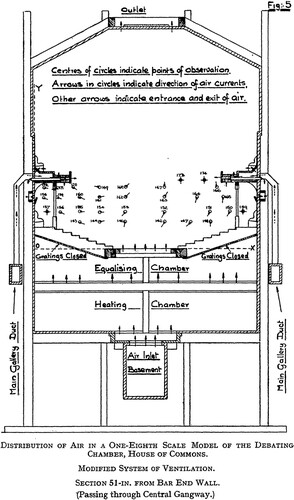
In their final scheme, the floor between the benches was completely closed and fresh introduced through inlets in the face of the galleries (NPL, Citation1924). The proposed second set of inlets within the benches was not included in these simulations. To verify the results of the simulations the NPL collaborated with the Office of Work in trials with a life-size mock up inside the chamber, which were undertaken during the summer recess of 1923 (Chief Engineer of Office of Works, Citation1923a, Citation1923b) The experimental system covered half the chamber and was separated from the other half by canvas partitions (Chief Engineer of Office of Works, Citation1923c). For these trials the floor inlets were covered and temporary inlets, serviced by cardboard ducts (), were installed at gallery level. The behaviour of the currents was examined visually through smoke tests (House of Commons, Citation1924).
The NPL concluded that the trials had confirmed the viability of Hill’s scheme and in its final report, dated 18 November 1924, the Office of Works also recommended its adoption (House of Commons, Citation1924). Sir Lionel Earle, Secretary to the Office of Works, wrote that the tests had shown that scheme succeeded in producing:
conditions laid down by Dr Hill, namely the gentle circulation of air over the heads of the occupants of the chamber, and the avoidance of any draughts at floor level.
(Earle, Citation1924)
Figure 16. Details of the proposed fresh air inlets inside the galleries, November 24, 1925.
Source: Historic England, Chest 9 ‘Houses of Parliament’.

These design studies represented a significant change of approach to improving the existing system. Previously it had been refined through incremental changes without challenging the overall concept. The inquiries undertaken after 1913 yielded more radical plans that were founded on the belief that longstanding problems of thermal discomfort could not be overcome without fundamental changes, requiring key features of the original system to be abandoned. These experimental design studies were an extension of the POEs and could be understood as a step towards establishing a wider framework of evidence-based practice, which, not dissimilar to Soft Landings, aimed to integrate the processes of designing, refining and evaluating buildings in use.
Re-imagining the thermal environment: early proposals for a mechanically conditioned chamber
The recommended scheme had to be debated and approved by Parliament before it could be adopted, but due to a major economic depression and divided opinions amongst MPs about the need for alterations, the Office of Works did not proceed with the scheme any further (Leitch, Citation1926). Fearing that it might fail to get a majority in the House, the Office of Works and HM Treasury initially intermitted the project for two years, and as Britain’s economic situation did not improve, it was postponed for another five years. The inquiries were only recommenced in 1931 in response to demands made by individual MPs and a petition signed by 225 MPs. The signatories complained about the ‘devitalising effect of the atmosphere’ and demanded the appointment of independent experts to examine conditions (Office of Works, Citation1931; House of Commons, Citation1931).
Between 1931 and 1938, the Office of Works re-examined the plans and collaborated with the Inter-departmental Committee in three further studies, which included an (1) environmental monitoring with modern equipment, (2) inquiries into the possibility of introducing mechanical air-conditioning and (3) trials with life-size models of new heating arrangements (First Commissioner of Works, Citation1936). Note that earlier inquiries into improving the thermal environment had focused primarily on reconfiguring the interior inlets and operational adjustments, yet the possibility of introducing new methods of heating, mechanical cooling or humidification had not been explored in detail before. In spring 1932, the Inter-departmental Committee reviewed Hill’s scheme and, arguing that it offered a viable solution to addressing the causes of discomfort, it advised that further research, as had been demanded by MPs, should be postponed until the scheme had been realized and its impact assessed (DSIR, Citation1932; Smith, Citation1932). Its realizations continued being delayed due to concerns about costs, but between October 1936 and July 1937, the Office of Works undertook additional experiments to further develop his scheme, focusing on aspects that the NPL had not examined during its studies in the 1920s. Two alternative proposals for reorganizing the air supply and heating arrangements around the benches were trialled (The Times, Citation1936). For these trials, three rows of benches inside the chamber were remodelled and a jury, composed of engineers and scientists from the MRC, BRS, NPL and Office of Works, was appointed to review the results. The first mock up was installed in October 1936 (Office of Works, Citation1936b) and tested inside the House for three months. During this trial the air temperature was reduced to 58°F and electric heating panels fixed to the backs of the sample benches (Bailey & Dufton, Citation1937). These had switches that enabled MPs to control the heat locally. The jury rejected the scheme for being ineffective. The radiant heat was not sufficient to warm a person or counteract the cooling effect of air currents, and an alternative arrangement was tested on 18 January 1937.
During the second trial, radiant warmth was provided through underfloor heating between the benches. The floor inlets were also closed and replaced with new inlets behind the backrests of the benches (). The jury concluded that the second trial was more successful. In its final report it wrote that ‘There was no draughts to the feet and feet were warm’ (Bailey & Dufton, Citation1937). The second mock-up, which the Inter-departmental Committee had recommended for adoption, remained in-situ for several months in order to collect feedback from MPs, and July 1937, the chief engineer reported that no complaints had been received (Anon., Citation1937).
Figure 17. Drawing by the Office of Works Engineering Division, June 15, Citation1937, showing the proposal for new inlets behind the backrests of the benches.
Source: National Archives, FD series, box 1, File 1210.
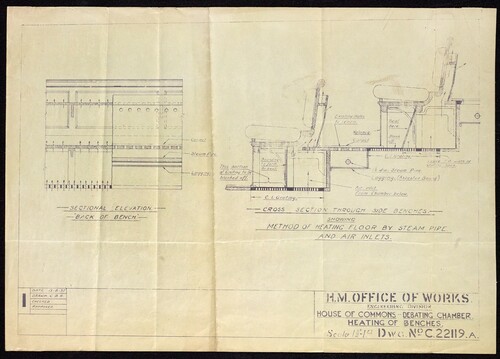
Between 1932 and 1937, the MRC also undertook a more detailed study of the climate conditions inside the two Houses, using modern monitoring equipment. These began in 1932 with the installation of automated temperature data loggers, which replaced the original 19th-century thermometers (Office of Works, Citation1936b), but between 1935 and 1936 humidity loggers and eupatheoscopes were added to collect data on other climatic factors affecting thermal comfort (Joint Committee of DSIR and MRC, Citation1936). The eupatheoscopes were used to determine the operative temperature, which was a simplified measure of thermal comfort, taking into account the combined effect of air temperature, humidity and air speed (Joint Committee of DSIR and MRC, Citation1935). These additional data were collected for a separate investigation into the benefits of air-conditioning. Their purpose was to determine how far the existing thermal conditions deviated from adequate range of temperatures and relative humidity, and how far they could be improved through mechanical humidification or refrigeration (Barker, Citation1935; Office of Works, 1937). In this study, the Office of Works collaborated with Dr Thomas Bedford (Davis, Citation1936), a physiologist from the MRC’s Industrial Health Research Board. Similar to Hill, Bedford was a leading researcher within the field of thermal comfort. He was leading major study on the indoor climates of factories and their effect on the health and productivity of workers. This study was published in 1936 in the paper The Warmth Factor in Comfort at Work (Bedford, Citation1936) and also referenced in Bedford’s report on the thermal environment of the two chambers (Bedford, Citation1938).
The idea of a mechanically conditioned chamber was first suggested by the Lords in the summer of 1935, when the temperature rose very high in the House of Lords chamber. A motion for an inquiry into the adoption of ‘up-to-date air conditioning plant’ was read in the House on 24 July 1935 (House of Lords, Citation1935). In May and July of the following year, the idea was also debated in the Commons, with MPs raising concerns about high temperatures and humidity (House of Commons, Citation1937a, Citation1937b, Citation1937c).
A White Paper, dated 16 July 1936, shows that the Office of Works seriously considered integrating air-conditioning into Hill’s scheme for remodelling the supply and heating arrangements (First Commissioner of Works, Citation1936). These plans were to be implemented in stages and air-conditioning, estimated to be the most expensive feature of the scheme, was to be installed at the final stage (House of Commons, Citation1937b). This scheme was significant as it represented another major step towards the abandoning of the 19th-century principles. It would have resulted in a fundamental transformation of the House of Commons, affecting its design from technological, operational and architectural perspectives. This radical scheme, however, was never realized. Following the completion of the monitoring in spring 1937, the MRC concluded that the benefits of introducing air-conditioning were limited. Referring to a relative humidity of 35–65% and temperatures of 65–70°F as adequate, Bedford found that the indoor climate rarely reached a state where air-conditioning was required (Bedford, Citation1938). Instead the Inter-departmental Committee recommended limiting the changes to Hill’s part of the proposal, arguing that it was sufficient to address the causes of thermal discomfort. In 1938, the Office of Works postponed the plans as resources were reallocated for the rearmament of the military (House of Commons, Citation1938a, Citation1938b). Owing to the outbreak of the Second World War in 1939, the re-modelling of the chamber never regained priority, and in 1941, the Luftwaffe destroyed the 19th-century chamber, marking the end of its post-occupancy history.
Revival of concepts: the rebuilding of the House of Commons
These pre-war investigations, however, were revisited after the war and significantly influenced the design of the new chamber, conceptually and in terms of the working methods. The plans were developed between 1943 and 1945 by Select Committees in collaboration with the architects Adrian and Giles Gilbert Scott and the engineers Oscar Faber and Robert Kell. Faber’s team re-examined the documentation of past POEs and design studies, and after Parliament had approved his proposals, also re-engaged the NPL to evaluate and refine the design experimentally with models (Prosser, Edmonds, & Steffens, Citation1950). Building on the physiological principles underlying Hill’s unrealized proposal, Faber’s team developed a new approach to introducing fresh air into the chamber, which involved the use of mid- and high-level openings. The mid-level inlets were located underneath the galleries and were used to inject air horizontally into the body of the House. The high-level openings were situated at ceiling level and were used to introduce air vertically from top of the House. The experimental methods used in its development were similar to those in 1920s, but the NPL deployed larger models at a scale of 1:4 and conducted more complex tests that combined air flow and thermal simulations ( and ). In addition to studying the direction and intensity of internal currents, using anemometers and smoke, the simulations covered indoor air temperature, diffusion of cold and hot air, and the impact of metabolic heat from occupants. The latter was simulated by placing electric light bulbs, covered with metal hoods, on the benches inside the model. These simulations were followed by tests with a life-size model to verify the results (Prosser et al., Citation1950). This comprised a 30-foot-wide sectional model and was erected inside the Earl’s Court Exhibition Centre, London. This was equipped with electric fans, ducts and nozzles for the supply and extraction of air, and an array of instruments, including anemometers, electric thermocouples and a smoke generator, was installed to monitor the interior conditions. Before its formal inauguration in October 1950, the system was also trialled in situ through a series of mock sittings, which Faber used to refine the operational settings. Two full days of trials were undertaken in September 1950, and to assess its performance under different levels of occupation, the number of guardsmen taking part in individual sittings varied from 400 to 950 (Hunter, Citation1950).
Figure 18. Scale model erected at the National Physical Laboratory (NPL) in 1945.
Source: NPL (Citation1948).
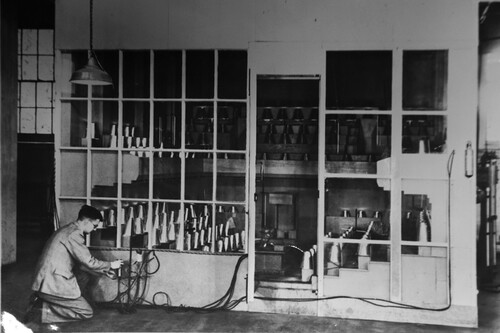
Figure 19. Diagrammatic cross-section of the scale model constructed at the National Physical Laboratory (NPL) in 1945.
Source: NPL (Citation1948).
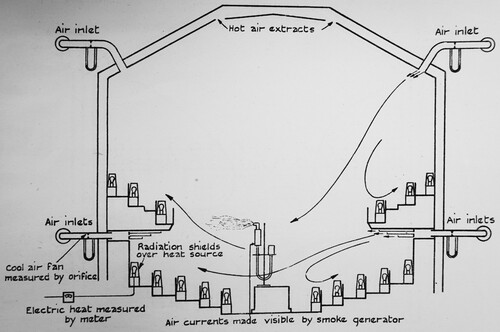
This process illustrates how the iterative and experimental working methods, which previously had been used to assess, refine and adapt existing arrangements inside the lost chamber, were adapted as a methodology for the design of new buildings.
Re-establishing control: social and technical feedback systems
In the 19th century, staff had acquired an intimate knowledge of building performance as a result of their involvement in the manual control and monitoring procedures. Many of these manual operations were automated in the new chamber using modern controls and monitoring technology. The system was equipped with a network of electric sensors and controls that enabled staff to monitor and operate the system remotely from a central control room (Engineering, Citation1950), and environmental monitoring and control operations were automated (Ministry of Works, Citation1954). The constant engagement of facilities management staff, however, remained an important feature of its operational design. This was significant as it ensured that staff maintained an intimate relationship with the building and its end user. A team of control engineers observed activities inside the chamber, analyzed measured data and monitored automated technical operations. They also collaborated with the resident engineer and the Minister of Works and Parliamentary Secretary in the collection and review of user feedback. Three control engineers were employed and operations were supervised by an engineer-in-charge (). The engineer-in-charge monitored the numbers of MPs inside the chamber remotely with the aid of a periscope, and if necessary could manually adjusted the settings (The Builder, 1945). According to a control manual from 1954, the manual mode was used to deal with ‘sudden or anticipated changes in occupancy’ or to make ad-hoc adjustments when the standard temperature and humidity settings were ‘not to the Members’ liking’ (Ministry of Works, Citation1954). A process for reviewing occupant feedback was also re-introduced. MPs gave oral or written feedback to the resident engineer, secretary or minister (Root, Citation1952). These men, who acted as liaisons between MPs and the control engineers, recorded and reviewed the feedback and also liaised with the control engineers about possible adjustments. In addition to informing the building management, it yielded important data for more in-depth analysis. In the first POE, which was undertaken in June 1952 (Bedford, Citation1952), the Ministry engaged the MRC to review the recorded climate data and occupant feedback to assess its performance from a thermal comfort perspective. From a facilities management perspective, it could be argued that the new system was part of a more longstanding institutional culture of producing knowledge of building performance that has its roots in the 19th century.
Conclusions: knowledge through human agency
This paper has shown that the House of Commons provided a setting for extensive building science research and technical experimentation. Its post-occupancy history, covering a period between 1854 and 1941, illuminated different ways in which knowledge of performance-in-use was acquired. These included many of the methods deployed in modern POEs and were also fully integrated into the process of improving and adapting the existing arrangements. In the 20th century, the POEs were complemented by experiments with physical models in order to test and refine proposals empirically before their implementation. Records of these POEs and design methods were also re-examined to inform the design of the new post-war chamber. Aside from yielding insights into the specific technical problems of the 19th-century system, these had illuminated some of the more universal challenges associated with ventilation and climate control inside legislative chambers that Faber had to re-address. This illustrated a historic approach to evidence-based practice that encompasses the processes of designing, evaluating and improving buildings.
This research has shown that to fully understand the significance of these historic practices, it is critical to distinguish between POE functions that were embedded within the day-to-day operational procedures and overseen by an in-house team of attendants, and those covered by several larger inquiries undertaken by the Office of Works, scientific panels and Parliament itself. These followed two distinct, yet complementary, approaches to acquiring knowledge of building in use. Much intelligence created in-house was in the form of practical experience that staff had accumulated over several years as a result of their constant and direct involvement in the operation and maintenance. Staff continually monitored the system and frequently undertook on-the-spot diagnostics of technical and managerial issues. Although less rigorous than the scientific studies used in the larger inquiries, these practical observations enabled staff to gain knowledge that could be directly used to inform ad-hoc physical alterations and operational adjustments. These building diagnostics can be interpreted as an example of ‘reflective practice’, a term that Donald Schön introduced in the 1980s to describe the nature of practice-based learning amongst professionals. This process involved on-the-spot reviews of measurements or direct observations, which Schön (Citation1983) refers to as ‘reflection-in-action’, and research involving the retrospective review of the recorded data and observations, which was an example of ‘reflection-on-action’. The day-to-day observations were recorded by staff in logbooks, letters and reports, but parliamentary reviews also included semi-structured interviews with staff, showing recognition of the importance of their experience to understanding the operational aspects of buildings.
This paper has also shown that the historic POEs were not limited to the evaluation of technical aspects. They engaged extensively with questions of human agency as a factor in environmental control. The post-occupancy history of the House of Commons was characterized by dynamic interactions between technology, end users and facilities management staff. Operationally, the system was highly dependent on the active participation of occupants and staff. As such, it could be interpreted as a historical example of a social–technical system (Cole, Robinson, Brown & O’Shea, Citation2008) and the post-occupancy history of the House of Commons represents a socio-technical case study that offers intimate insights into the process of managing socio-technological systems and associated practical challenges (Lowe, Chui, & Oreszczyn, Citation2018).
In the case of the House of Commons, human agency had two distinct roles within the day-to-day operations. The first role was to facilitate an intelligent operation of the technological system, which in the 19th century relied entirely on the physical labour and intelligence of human operators. The post-occupancy history has illustrated the depth of engagement by staff with the system in use was largely dictated by the technology and also that it declined in the 20th century as a result of a drive towards the automation of monitoring and control operations. The system in the rebuilt House of Commons illustrates how this role was redefined through new technology. The second role was to sustain a constant dialogue with end users, which was facilitated through formal feedback procedures that were fully embedded within the building management regime. It enabled staff to accumulate an intimate knowledge of how occupants, both collectively and individually, perceived the indoor environment and how their expectations and demands affected the environmental control operations. In this process, the responsibility of the staff was to provide a human interface between the occupants and technology.
It is evident that this approach to assessing user perception was less systematic than modern occupant surveys, such as the one developed by Building Use Studies (BUS). It did not include formal methods of rating perceived thermal comfort following the predicted mean vote (PMV) model. The historical approach, however, allowed user engagement to be ongoing. It also enabled a process that was inherently participatory and collaborative. End users were expected to actively participate in the control of their environment, and that participation was supported at the institutional level. Facilities management was understood as a shared responsibility. As a client body responsible for the operation and maintenance of the parliamentary estate, the Office of Works and its local staff within the Ventilation Department of the Palace cooperated extensively with end users in the management, evaluation and improvement of environmental control. As end users, MPs were also exceptionally active, exercising significant influence over the evolution of the system physically and operationally. Although Parliament was clearly an unusual occupant, not the least as it had the power, institutional infrastructure and financial resources to study and improve building performance, the House of Commons provides a potential model for rethinking the relationship between technology, users and facilitates management in current practice. This raises the following important question: If modern POEs need to go beyond the commissioning of one-off studies (typically confined to periods of two to three years), how might POEs adopt methods that enable more long-term engagements with buildings in use? Contemporary practice is also characterized by a divide between what is considered the domain of POEs and facilities management. The presented historical model suggests that this chasm could be overcome by changing the nature of facilities management practice itself. Could this be achieved by supplying facilities management staff with a separate toolkit of simpler building diagnostic techniques that could deployed in routine building operations, complementing those deployed in more rigorous POE studies?
Disclosure statement
No potential conflict of interest was reported by the author.
Additional information
Funding
Notes
1. Relative humidity is determined by taken two parallel readings from dry- and wet-bulb thermometers. The greater the difference between the two readings, the lower is the relative humidity.
2. Select Committees are small groups of MPs formally appointed by the House to undertake an inquiry into particular issues, involving, amongst others, the hearing of experts witnesses and commissioning of studies, and present a report with recommendations to Parliament.
3. Before the development of modern CFD simulations for the modelling of three-dimensional fluid flows, engineers relied on the use of physical models (Khalil, Citation2012).
References
- Anon. (1937, July 15). Letter to Secretary of Office of Works. National Archives (Work 11 series, Box 357).
- Bailey, A., & Dufton, A. (1937, November). Report on visits paid to the House of Commons. National Archives (DSIR 3 Series, Box 20).
- Baines, F. (1923, April 10). Letter to Lloyd. National Archives (DSIR 3 Series, Box 20).
- Barker, R. (1935, September 16). Letter to DSIR Advisory Council. National Archives (DSIR 3 Series, Box 20).
- Bathurst, C. (1914, May 14). Letter to Lord Beauchamp. National Archives (Work 11 Series, Box 202).
- Bedford, T. (1936). The warmth factor in comfort at work. Reports of the Industrial Health Research Board Nr 76 (1936).
- Bedford, T. (1938, January). Notes on questions relating to humidity with special reference to the ventilation of the Houses of Parliament. National Archives (DSIR 3 Series, Box 20).
- Bedford, T. (1952, June). Report: House of Commons ventilation. National Archives, FD 1 Series, Box 144).
- Beswick F. (1946, February 7). Letter to Harold Wilson. National Archives (Work 11 Series, Box 403), London.
- Bordass, W. (2003). Learn more from what we build. In S. Macmillan (Ed.), Designing better buildings (pp. 21–32). London: Spon.
- Bossom, A. C. (1937a, November 15). Ventilation in the House. The Times, 10.
- Bossom, A. C. (1937b, November 9). Changes in the House. The Times, 12.
- Bossom, A. (1938, March 2). Letter to P. Sassoon. National Archives (Work 11 Series, Box 357), London.
- British Medical Journal. (1884). The atmosphere of the House of Commons. British Medical Journal, 2(1228), 83.
- British Medical Journal. (1891). The ventilation of the House of Commons. British Medical Journal, 2(1596), 273.
- Burgess, J. (1946, February 1). Letter to H. L. Davis. National Archives (Work 11 Series, Box 403).
- Chief Engineer of Office of Works. (1923a, July 6). Letter to Secretary of Works. National Archives (Work 11 Series, Box 202).
- Chief Engineer of Office of Works. (1923b, July 8). Letter to Director of Works. National Archives (Work 11 Series, Box 202).
- Chief Engineer of Office of Works. (1923c, October 5). Letter to Director of Works. National Archives (Work 11 Series, Box 202).
- Chief Engineer of Office of Work. (1926, November 3). Letter to Secretary of Works. National Archives, Work 11/202) (Work 11 Series, Box 202).
- Cole, R.J., Robinson, J., Brown, Z. & O’Shea, M. (2008). Recontextualising the notion of comfort. Building Research & Information, 36(4), 323–336. doi:https://doi.org/10.1080/09613210802076328
- Coleman, S., & Robinson, J. (2018). Introducing the qualitative performance gap: Stories about a sustainable building. Building Research & Information, 46(5), 485–500. doi: https://doi.org/10.1080/09613218.2017.1366138
- Cook, J., & Hinchcliffe, T. (1996). Delivering the well-tempered institution of 1873. Architectural Research Quarterly, 2–1, 66–75.
- Cooper, G. (1998). Air-conditioning America: Engineers and the controlled environment, 1900–1960. Baltimore: Johns Hopkins University Press.
- Davis, H. (1936, July 8). Letter to Secretary of MRC. National Archives (DSIR 3 Series, Box 20).
- Department of Scientific and Industrial Research (DSIR). (1925, November 24). Inter Departmental Conference Extract from Minutes of Meeting. National Archives (DSIR 3 Series, Box 20).
- Department of Scientific and Industrial Research (DSIR). (1926, May). Report on development of research since 1913. National Archives (DSIR 3 Series, Box 20).
- Department of Scientific and Industrial Research (DSIR). (1932, April 27). Minutes of 4th Meeting held on 27 April 1932. (DSIR 3 Series, Box 20).
- Earle, L. (1924, December 30). Letter to the Lords Commissioners of H.M. Treasury. National Archives (Work 11 Series, Box 202).
- Engineering. (1950, November 24). Engineering feature of the new Commons. Engineering, 396.
- Evening Telegraph. (1913, August 11). Hunting the draught. Evening Telegraph, 5.
- First Commissioner of Works. (1936, July 16). White Paper: Ventilation of the House of Commons (DSIR 3 Series, Box 20).
- Fletcher, W. M. (1926, May 14). Letter to Sir L. Earle. National Archives (DSIR 3 Series, Box 20).
- General Board of Health. (1857). Report of the Commissioners appointed to inquire into the warming and ventilation of dwellings. London: J. Taylor.
- Graham-Smith, G. S. (1903). The microorganisms in the air of the House of Commons. Journal of Hygiene, 3(4), 498–514. doi: https://doi.org/10.1017/S002217240003299X
- Gurney, G. (1855, October 18). Memorandum on the warming and ventilating and lighting services. National Archives (Work 11 series, Box 26, Folder 3).
- Halliday, S. (2001). Death and miasma in Victorian London: An obstinate belief. British Medical Journal, 323(7327), 1469–1471. doi: https://doi.org/10.1136/bmj.323.7327.1469
- Harrington, J. (1869). The Abbey and the Palace of Westminster. London: S. Low, Son & Marston.
- Hattersley, A. (1945, November 15). Memorandum: Heating complaints commons chamber. National Archives (Work 11 Series, Box 403).
- Hill, L. (1926, May). Report on development of research since 1913. National Archives (DSIR 3 Series, Box 20).
- Hill, L., & Argyll, C. (1925). Health and environment. London: E. Arnold.
- Hill, L., Flack, M., McIntosh, J., Rowlands, R., & Walker, H. (1913). The influence of the atmosphere on our health and comfort in confined and crowded places. Paper presented at the Smithsonian Institution, Washington, DC.
- HM Treasury. (1914, December 23). Letter to Office of Works. National Archives (Work 11 Series, Box 202).
- House of Commons. (1851–52). Estimates for civil services (1851–52 (I.VII)) 6, 13–18.
- House of Commons. (1852). Ventilation and lighting of the House: The Second Report (HC 1852 (252–402)).
- House of Commons. (1854–55). Copy of Mr. Gurney’s report to the office of works, on his experiment for withdrawing and decomposing the noxious effluvia from the sewers in the neighbourhood of the Houses of Parliament (HC 1854–55 (105)).
- House of Commons. (1854a). Ventilation of the House of Commons: The first report (HC 1854 (149)). London: HMSO.
- House of Commons. (1854b). Ventilation of the House of Commons: The second report (HC 1854 (270)).
- House of Commons. (1855–56). Estimates for civil services (HC 1855–56 (I–VII)), 14.
- House of Commons. (1857–58). River Thames: Report (HC 1857–8 (442)).
- House of Commons. (1859). 15 July debate (vol. 154 col. 1333–58).
- House of Commons. (1862–63). Estimates for civil services (1862–63 (I–VII)) 21.
- House of Commons. (1863). 1 June debate (vol. 171 col. 177–8 177).
- House of Commons. (1865). 19 May debate (vol. 179 col. 594–611).
- House of Commons. (1866a). 30 April debate (vol. 183 col. 196–209.
- House of Commons. (1866b). Copy of report on the ventilation, warming and lighting of the Houses of Parliament by Dr Percy (HC 1866 (98)).
- House of Commons. (1867–68). House of Commons (Arrangements): Report (HC 1867–68 (451)).
- House of Commons. (1871). 1 June debate (vol. 206 col. 1381–433).
- House of Commons. (1871–72). Estimates for civil services (HC 1871–72 (I–VII)) 70.
- House of Commons. (1872–73). Estimates for civil services (HC 1872–73 (I.VII)) 23.
- House of Commons. (1882). 25 July debate (vol. 272 col. 1686).
- House of Commons. (1884). Ventilation of the House: Report (HC 1884 (309)).
- House of Commons. (1884–85). Sanitary arrangements at the Houses of Parliament: Report (HC 1884–85 (328)).
- House of Commons. (1886). Ventilation of the House: Second report (HC 1886 (173)).
- House of Commons. (1889). 8 April debate (vol. 334 col. 1878–902).
- House of Commons. (1890–91a). Estimates for civil services (1890–91 (I.VII)) 25.
- House of Commons. (1890–91b). House of Commons (ventilation): Report (HC 1890–91 (371)).
- House of Commons. (1892–93). Estimates for civil services 1892–93 (I.VII)) 17
- House of Commons. (1891). 14 May debate (vol. 353 cc709–10).
- House of Commons. (1898). 14 June debate (vol. 59 col. 221–2).
- House of Commons. (1902). House of Commons: first report (HC 1902 (227)).
- House of Commons. (1906a). 14 June debate (vol. 158 col. 1115).
- House of Commons. (1903). House of Commons Ventilation report (HC 1903 (283)).
- House of Commons. (1905, December). Report and recommendations by Dr. M. H. Gordon, December 1904 (HC 1905 Cd. 2404).
- House of Commons. (1906a). Report and recommendations of the committee appointed to investigate and advise the First Commissioner of Works on the question of improving the ventilation of the House of Commons (1906 (Cd. 3035)).
- House of Commons. (1906b). Report by Dr. M. H. Gordon, on an investigation of the ventilation of the debating chamber of the House of Commons (1906 (Cd. 3068)).
- House of Commons. (1912a). 27 March debate (vol. 36 col. 428–9 428).
- House of Commons. (1912b). 4 June debate (vol. 39 col. 69–84 69).
- House of Commons. (1912c). 10 October debate (vol. 42 col. 504).
- House of Commons. (1913a). 3 June debate (vol. 53 col. 778–9).
- House of Commons. (1913b). 13 June debate (vol. 53 col. 1975–83).
- House of Commons. (1913c). Report from the Select Committee on House of Commons ventilation (HC 1913 290).
- House of Commons. (1914). House of Commons (ventilation): Report (HC 1914 (445)).
- Houses of Commons. (1920a). 24 February debate (vol. 125 col. 1497).
- Houses of Commons. (1920b). 27 April debate (vol. 128 c1041).
- House of Commons. (1924, November 18). Frank Baines, Memorandum (HC 1931 Cmd. 3871).
- House of Commons. (1930). 10 February debate (vol. 235 col. 28–9).
- House of Commons. (1931). 29 July debate (vol. 255 col. 2278).
- House of Commons. (1937a). 14 June debate (vol. 325 cc18–90).
- House of Commons. (1937b). 19 July debate (vol. 326 col. 1771–2).
- House of Commons. (1937c). 7 June debate (vol. 324 cc1410–1).
- House of Commons. (1938a). 9 May debate (vol. 335 col. 1224–5).
- House of Commons. (1938b). 14 November debate (vol. 341 cc497–8).
- House of Commons. (1952). 23 May debate (vol. 501 col. 87–8W 87).
- House of Lords. (1854). Possibility of improving the ventilation and lighting of the House: First Report (HL 1854 (384)).
- House of Lords. (1869). Office of the Clerks of Parliament: Report (HL 1869).
- House of Lords. (1935). 14 July debate (vol. 98 col. 842–6 842).
- Hunter, G. (1950, September 19). Report: Troops for testing new chamber September 7th and 11th, 1950. National Archives (Work 11 Series, Box 418).
- Joint Committee of DSIR and MRC. (1935, December 13). Minutes of Meeting. National Archives (DSIR 3 Series, Box 20).
- Joint Committee of DSIR and MRC. (1936, October 29). Minutes of Meeting. National Archives (DSIR 3 Series, Box 20).
- Khalil, E. (2012). CFD history and applications. CFD Letters, 4(2), 43–46.
- Leaman, A., & Bordass, B. (2001). Assessing building performance in use. 4: The Probe occupant surveys and their implications. Building Research & Information, 29, 129–143. doi: https://doi.org/10.1080/09613210010008045
- Leaman, A., Stevenson, F., & Bordass, B. (2010). Building evaluation: Practice and principles. Building Research & Information, 38(5), 564–577. doi:https://doi.org/10.1080/09613218.2010.495217
- Leitch. (1926, November 3). Letter to Davidson Pratt, 3 November 1927, National Archives, Work 11 Series, Box 202).
- Lowe, R., Chui, L., & Oreszczyn, T. (2018). Socio-technical case study method in building performance evaluation. Building Research & Information, 46(5), 469–484. doi: https://doi.org/10.1080/09613218.2017.1361275
- MacKenzie, W. (1863). On the mechanical ventilation and warming of St George’s Hall, Liverpool. Proceedings of the Institution of Mechanical Engineers 14(1), 194–208. doi: https://doi.org/10.1243/PIME_PROC_1863_014_016_02
- Markham. (1937, July 20). Letter to Sir P. Sassoon. National Archives (Work 11 Series, Box 357).
- Ministry of Works. (1942). Existing heating and ventilating system, House of Commons, first floor plan. Historic England Archive (Chest 13), Swindon.
- Ministry of Works. (1954, August). House of Commons: Automatic control of the air-conditioning system for the chamber of the House. Strategic Estates Archives, Houses of Parliament (Uncatalogued item).
- National Physical Laboratory (NPL). (1924, January 28). On the progress during 1923–24 of the investigation on the ventilation of the Debating Chamber of the House of Commons. National Archives (DSIR 3 Series, Box 20).
- National Physical Laboratory (NPL). (1948, November). Report on the model investigations of a ventilation system for the debating chamber of the House of Commons. National Archives (Work 11 Series, Box 418).
- Office of Works. (1867a). Cross-section through House of Commons National Archives (Work 29 series, plan 2984), London.
- Office of Works. (1867b). Plan shewing [sic] the arrangements for the discharge of foul air from House of Commons, National Archives, Work 29 series, plan 2982).
- Office of Works. (1867c). Plan Mezzanine Floor. National Archive (Work 29 series, plan 2981).
- Office of Works. (1930, February 7). Ventilation attendants. Length of services and sick leave taken since January 1924. National Archives, Work 11 series, box 202).
- Office of Works. (1931, August 5). Letter to DSIR. National Archives (DSIR 3 Series, Box 20).
- Office of Works. (1936a, July). House of Commons Ventilation – Note for possible supplementary. National Archives, Work 11 series, Box 357).
- Office of Works. (1936b, October 30). Memorandum: Houses of Parliament heating, National Archives, Work 11 series, Box 357).
- Office of Works. (1937, October 13). Letter to MRC (DSIR 3 Series, Box 20).
- Pall Mall Magazine. (1891, May 21). The prevalence of influenza – The recovery of Mr. Gladstone, Pall Mall Magazine, 4.
- Patey, J. (1913, April 12). Report to Office of Works. National Archives (Work 11 Series, Box 202).
- Preiser, W., & Hardy, A. (2015). Historic review of building performance evaluation. In Architecture beyond criticism (pp. 146–159). London: Routledge.
- Prosser, B., Edmonds, R., & Steffens, R. (1950, August 18). Model investigations of a ventilation system for the debating chamber of the House of Commons. Engineering, 127, 165–168.
- Reid, D. B. (1844). Illustrations of the theory and practice of ventilation. London: Longman, Brown, Green & Longmans.
- Root, F. (1952, May 20). Letter to J. G. Duncan. National Archives, FD 1 Series, Box 444).
- Sassoon, P. (1938, March 3). Letter to M. Tate MP. National Archives (Work 11 Series, Box 357).
- Schoenefeldt, H. (2008). The Crystal Palace, environmentally considered. Architectural Research Quarterly, 12(3–4), 283–294. doi: https://doi.org/10.1017/S1359135508001218
- Schoenefeldt, H. (2011). Adapting glasshouses for human use: Environmental experimentation in Paxton’s designs for the 1851 Great Exhibition building and the Crystal Palace, Sydenham. Architectural History, 54, 233–273. doi: https://doi.org/10.1017/S0066622X00004068
- Schoenefeldt, H. (2014). The temporary Houses of Parliament and David Boswell Reid’s architecture of experimentation. Architectural History, 57, 175–215. doi: https://doi.org/10.1017/S0066622X00001416
- Schoenefeldt, H. (2016). The lost (first) chamber of the House of Commons. AA Files, 72, 44–56.
- Schoenefeldt, H. (2018). The historic ventilation system of the House of Commons, 1840–52: Revisiting David Boswell Reid’s environmental legacy. Journal of the Society of Antiquaries, 98, 245–295. doi: https://doi.org/10.1017/S0003581518000549
- Schön, D. (1983). The reflective practitioner – How professionals think in action. London: Temple Smith.
- Smith, F. (1932, June 7). Letter to Office of Works (DSIR 3 Series, Box 20).
- Stanton, T. (1909). Experiments on wind pressure. National Physical Laboratory Collected Researches, 5, 167–202.
- Tate, M. (1938, March 2). Letter to P. Sassoon. National Archives (Work 11 Series, Box 357).
- The Builder. (1945, September 7). The rebuilding of the House of Commons, a talk by Mr Adrian Gilbert Scott. The Builder, 185–186.
- The Graphic. (1875, July 31). Ventilation of the House of Commons. The Graphic, 111–12.
- The Times. (1870, February). Ventilation of the Houses of Parliament. The Times, 6.
- The Times. (1887, April 15). Ventilation of the Royal Courts of Justice. The Times, 3.
- The Times. (1914a, March 27). Monotony of air and speech. The Times, 12.
- The Times. (1914b, May 1). Monotony in the commons atmosphere. The Times, 5.
- The Times. (1936, July 30). House of Commons ventilation – Experiments with some electric panels. The Times, 8.
- Tomlinson, G. (1945, November 15). Letter to W. H. Ayles. National Archives (Work 11 Series, Box 403).
- Tredgold, T. (1824). Principles of warming and ventilating public buildings. London: J. Taylor.
- Ventilation Department. (1853). Ventilation Department. Registers of temperature control and ventilation for the House of Commons March – June 1853. Parliamentary Archives (OOW 5 series, book 1).
- Ventilation Department. (1854). Ventilation Department. Registers of temperature control and ventilation for the House of Commons January–April 1854. Parliamentary Archives (OOW 5 series, book 2), London.
- Ventilation Department. (1923–28). Register of temperature control and ventilation for the House of Commons, February 1923–December 1928. Parliamentary Archives (OOW 5 series, book 3).
- Ventilation Department. (1943–47). Ventilation Department. Register of temperature control and ventilation for the House of Lords, March 1943–July 1947. Parliamentary Archives (OOW 5 series, book 4).
- Wilson, H. (1946a, February 3). Letter to F. Beswick. National Archives (Work 11 Series, Box 403).
- Wilson, H. (1946b, February 4). Letter to F. Beswick. National Archives (Work 11 Series, Box 403).
- Wilson, H. (1946c, February 23). Letter to F. Beswick. National Archives (Work 11 Series, Box 403).
- Yu, S. Y. (2015). Livestock to Dead Meat– a case study on Smithfield Market, Research paper, MSc in Architecture and Sustainable Environment, University of Kent, 2015.

